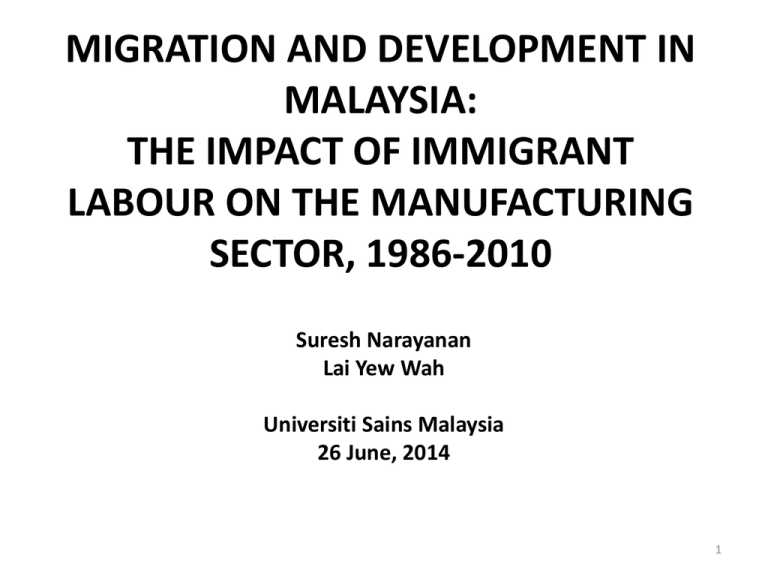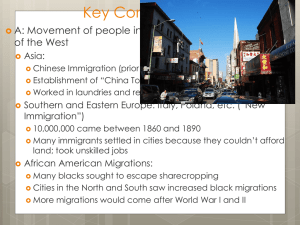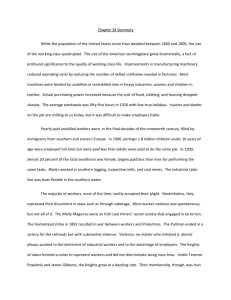Slides
advertisement

MIGRATION AND DEVELOPMENT IN MALAYSIA: THE IMPACT OF IMMIGRANT LABOUR ON THE MANUFACTURING SECTOR, 1986-2010 Suresh Narayanan Lai Yew Wah Universiti Sains Malaysia 26 June, 2014 1 Rapid increase of immigrants in manufacturing, between 1990-2009 Table 1 Distribution of Immigrants by Sector Year Agriculture Manufacturing Construction NonDomestic Services 1990 37.7 8.8 34.4 19.1 2009 26.1 32.0 15.6 10.6 Source: Devadason & Chan, 2014 2 Why the focus on manufacturing? • Because in the other three sectors, agriculture, construction and services immigrants took jobs avoided by natives • Low paying & poor conditions of work • Therefore immigrants complemented natives • In comparison, manufacturing offered better pay and conditions of work • Natives not averse to employment here 3 Three Concerns • Did immigrants displace natives by taking away jobs from them? • Did presence of immigrants impede wage growth in manufacturing? • Did presence of immigrants lower productivity growth in manufacturing? 4 Background Table 2 : Growing Share of Immigrants in the Manufacturing Work force Year Immigrants in % of manufacturing work manufacturing force 1991 21,162 2.17 1995 142,380 10.25 1997 208,335 14.76 1999 179,427 13.21 2001 211,702 15.21 2003 271,444 18.06 2010 515,000 28.4 Source: 1991-2003 adapted from Narayanan and Lai (2012) 2010 share was based on total employment from the Census of Manufacturing (2011: 14) and the number of immigrants in manufacturing as stated in World Bank (2013: 24) 5 Background Table 3 Immigrants by Subsectors within Manufacturing 1991 2003 Subsector Immigrants % of total Immigrants Food manufacturing 2,171 10.26 17,126 Textile & apparel Plastic products Rubber products Wood products Electrical & Electronics Other Total % of total 6.31 412 185 265 12,466 1,455 1.95 0.87 1.25 58.91 6.88 33,032 21,615 15,054 73,111 51,518 12.17 7.96 5.55 26.93 18.98 4,208 21,162 19.88 100.0 59,989 271,444 22.10 100 Source: Narayanan & Lai (2012) 6 Complements or Substitutes? 1986-95: Illegal Complements • The export-oriented manufacturing sector experienced unprecedented growth • Output grew at nearly 12% in the two periods, 19861990 and 1991-1995. • The increase in labour demand led to employment growth of 9.4% and 5.9% per annum, respectively • But real wage rate growth in the first period was negative but employment expanded because immigrants were being used illegally • This suggests that immigrant labour complemented natives during this period of ‘labour shortage’ 7 1991-95: Legal Complements • 1991-95; Output & employment continued to grow • Real wage rate recovered & grew at 4.2% per annum • Immigrants were allowed & required by law to be paid equivalent to natives • This ensured real wages grew as well 8 Post 1995: Substitutes • In the face of rising wages, immigrants were preferred not because they were cheaper but for non-wage reasons • Contacts informed us they were – less particular about working overtime during holidays, – avoided taking extended breaks during festive seasons – were available as contract workers thereby reducing overheads. – lent flexibility to the operations because they could be laid off easily during a demand downswing (See also Periera, 2010; Devadason and Chan, 2014: 2223; and World Bank, 2013: 104) 9 Post 1995: Substitutes • As legally employed immigrants increased in manufacturing, wage rate growth slowed down from 3.7% (1996-00) to a mere 1.6% per annum (2001-2010). • This suggests that immigrants were rapidly replacing natives and there was less pressure from them to push for higher wages. 10 Other supporting evidence.. • An econometric exercise done by the World Bank (2013:44) for a time period that is not exactly clear found that for every one thousand foreigners employed in agriculture and mining, 671 new jobs were created for Malaysians. • In services, the figure was 741 additional jobs for natives. • However, the effect in manufacturing was much smaller and not statistically significant. • Therefore , the small positive effects of employing immigrants were felt in sectors that were of lower appeal to Malaysians, where migrants played a complementary role • But not in manufacturing where they were closer substitutes to natives in the types of jobs they performed. 11 Other supporting evidence • Immigrants were largely low or unskilled,; therefore they displace low or unskilled natives in manufacturing or elsewhere. • The World Bank study (2013: 48) confirms this point though the impact was estimated for the economy as a whole, not the manufacturing sector in particular. • Engaging 100 new foreign workers would leave 114 natives with primary education or less without jobs • The new jobs will be created only for natives with education ranging from lower secondary to STPM level. • The study suggest that the benefits to better educated workers were not apparent in manufacturing: • “The results give a clear indication that the main beneficiaries of immigration in Malaysia are older workers with medium education levels who work in … service and agriculture and mining sectors” (World Bank, 2013: 51; emphasis added). 12 Impact on Wages: 1986-1990 • During this period, immigrants were not legalized, though they were being used • Employers paid them lower wages and little benefits • The growth of real wage rate was negative (1.1 per cent) 13 Impact on Wages 1991-2010 • In 1991, immigrants were legally permitted in manufacturing • They had to be paid the same as natives and enjoy similar benefits • Therefore, employer had no cost saving by hiring immigrants • But they were preferred for non-wage reasons noted earlier. • The increased supply of immigrants would only lower the wage rate if the increase in labour supply offsets the increase in the demand for labour. • Real wage rate growth in the manufacturing sector as a whole decreased from 3.7 % (between 1996-2000) to 1.6 % after 2001—a period that saw the free inflow of immigrant workers. 14 Supporting evidence.. • We used firm level data for 2006 to examine the impact of immigrant workers on firm level wages following a model suggested by Athukorala and Devadason (2012) • Our findings confirm that increasing immigrant presence has a small, but significant, downward pressure on wages • A 10% increase in the share of immigrants in a firm’s workforce lowered overall wages by 0.6% • And wages of unskilled workers by 1.23% • Therefore unskilled workers are more hurt by the presence of immigrants 15 Supporting evidence • Athukorala and Devadason (2012) used panel data for 2006-2008 in a similar exercise looking at inter-industry wage differentials. • Our results are consistent with theirs & remarkably close in magnitude • They found that a 10% increase in the share of immigrants in an industry lowered overall wages by 0.67% • And wages of unskilled workers by 1.3% 16 Productivity: 1985-2004 • The growth of productivity per worker was low in the periods when immigrants were used illegally in the sector. • It recorded impressive growth when immigrants were legalized and complemented the natives in manufacturing (till about 1999). • But productivity growth has been falling since 2000 consistent with the rising share of low and unskilled immigrant workers in manufacturing during this period. • However, K/L ratio has been rising consistently till 2005, after which a small dip is seen 17 Productivity…. • One explanation is that the easy availability of labour encouraged employers to sustain output by the use of more capital equipment that needed labour (labour–using technologies) rather than using technologies that substituted labour (capital-using technologies). • Lewis (2005) in his firm level study in the US for 1988-1993 period found that the skills available to employers drive the spread of skill-complementary technologies. • A large supply of unskilled immigrant labour led to the adoption of technologies consistent with lower skilled labour. Consequently, although output and capital-labour ratio increased, productivity growth slowed down. 18 Conclusions • Foreign workers complemented natives in the initial period (1986-95) when there was a sudden labour ‘shortage’. • In later periods (1996-2005), when wage levels continued to rise, immigrant labour displaced local workers because employers preferred them so as to reduce non-wage costs. • The influx of immigrant labour undermined the growth of real wages of all workers, and the wages of unskilled workers, in particular • Immigrant presence may have slowed down productivity growth. 19 Conclusions • A recent study by the World Bank (2013) showed much of the benefits from immigrants were in sectors like agriculture and mining, construction and non-domestic services, where unskilled immigrants clearly complemented better skilled native workers. • Benefits also from immigrants also went to native groups with medium-levels of education and not to those with poor or no education. • Findings with respect to positive gains in manufacturing were ambiguous. 20 Policy Implications • • • • • Unskilled immigrant labour helped manufacturing output expand, though productivity growth slowed down. Immigrants denied unskilled natives jobs in manufacturing and slowed down the growth of the real wages Since wages of unskilled workers were already low, and even a small reduction in wage growth will set them back more seriously than the figures suggest. They also do not have adequate protection from established social security nets The large presence of immigrants in low paying jobs and the consequent slower growth of wages here have made these jobs less attractive to a new generation of Malaysians 21 Policy Implications • Foreign unskilled workers still needed to replace natives who, through education and skill development, prefer better paying jobs. • But we must monitor and manage the inflows to minimize the negative effects on the livelihoods of natives still stuck in such jobs. • Need effective enforcement and monitoring mechanisms to ensure that immigrants do not crowd out natives still dependant on low skill jobs. • Current policies focus on raising the cost of using immigrants by equalizing the wages and benefits and by imposing ceilings and raising levies on foreign workers. • These measures also have the effect of encouraging the employment of irregular immigrants, if pushed too far. 22 Policy Implications • Immigrants respond both to job opportunities in the host economy and the lack of employment at home. • Therefore, there is another neglected aspect that needs attention • Strengthening policies that increase investment, enhance productivity and generate high growth and high income jobs will naturally reduce opportunities for unskilled immigrants and help to ebb their flow. • Investments in education and skill enhancement among natives will not only support such growth policies but will also provide immunity from competition from unskilled foreign workers. 23 THANK YOU 24







